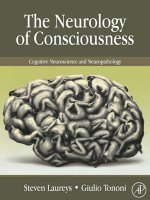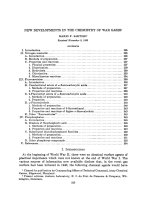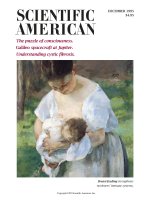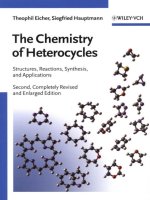The joyous cosmology adventures in the chemistry of consciousness
Bạn đang xem bản rút gọn của tài liệu. Xem và tải ngay bản đầy đủ của tài liệu tại đây (17.44 MB, 154 trang )
joyous
cosmology
t he
Also by Alan Watts
Behold the Spirit
Beyond Theology
The Book
Cloud-Hidden, Whereabouts Unknown
Myth and Ritual in Christianity
Nature, Man and Woman
Psychotherapy East and West
The Spirit of Zen
The Supreme Identity
Tao
This Is It
The Way of Zen
The Wisdom of Insecurity
Also by Alan Watts from New World library
Does It Matter?
Eastern Wisdom, Modern Life
In My Own Way
Still the Mind
What Is Tao?
What Is Zen?
joyous
cosmology
t he
Adventures in the Chemistry
of Consciousness
Al AN W. WAt ts
With a new introduction by Daniel Pinchbeck
Foreword by Timothy Leary, PhD,
and Richard Alpert, PhD
SECOND EDITION
New World Library
Novato, California
New World Library
14 Pamaron Way
Novato, California 94949
Copyright © 1962 by Pantheon Books, a division of Random House, Inc.
Copyright © 2013 by Joan Watts and Anne Watts
Introduction copyright © 2013 by Daniel Pinchbeck
Originally published in 1962 by Pantheon Books
All rights reserved. This book may not be reproduced in whole or in part, stored in a
retrieval system, or transmitted in any form or by any means—electronic, mechanical, or other—without written permission from the publisher, except by a reviewer,
who may quote brief passages in a review.
Text design by Tona Pearce Myers
Library of Congress Cataloging-in-Publication Data
Watts, Alan, 1915–1973.
The joyous cosmology : adventures in the chemistry of consciousness / Alan W.
Watts ; with a new introduction by Daniel Pinchbeck ; foreword by Timothy Leary,
PhD, and Richard Alpert, PhD. — Second edition.
pages cm
“Originally published in 1962 by Pantheon Books.”
Includes bibliographical references.
ISBN 978-1-60868-204-1 (pbk. : alk. paper) — ISBN 978-1-60868-205-8 (ebook)
1. Consciousness. 2. Hallucinogenic drugs. I. Title.
BF320.W3 2013
154.4—dc23
2013004835
First printing of second edition, May 2013
ISBN 978-1-60868-204-1
Printed in the USA on 100% postconsumer-waste recycled paper
New World Library is proud to be a Gold Certified Environmentally
Responsible Publisher. Publisher certification awarded by Green Press
Initiative. www.greenpressinitiative.org
10 9 8 7 6 5 4 3 2 1
To the people of Druid Heights
coNteNts
Description of Photographs
ix
Introduction by Daniel Pinchbeck
xi
Foreword by Timothy Leary, PhD,
and Richard Alpert, PhD
xv
Preface
Prologue
xxiii
1
The Joyous Cosmology
25
Epilogue
81
Appendix: Psychedelics and Religious Experience
95
About the Author
119
descriptioN of photogrAphs
Page 28
Page 32
Page 35
Page 36
Page 41
Page 43
Page 46
Page 49
Page 51
Page 53
Page 54
Page 59
Page 60
Page 64
Page 66
Page 68
Page 71
Page 74
Page 79
Page 85
Page 94
Polished agate surface (Wolf Strache)
Plumage of a francolin (Wolf Strache)
Back of a goliath beetle (Wolf Strache)
Glass sponge (Wolf Strache)
Harp shell (Wolf Strache)
Brazilian peacock butterfly (Wolf Strache)
Radiolaria skeletons
Feeding pattern of a caterpillar (Wolf Strache)
Coral formations (Barbara Gould)
Fructification of clematis (Wolf Strache)
Pinions of argus pheasant (Wolf Strache)
Shattered glass (Ken Knollenberg)
Wall surface (Barbara Gould)
Skeleton of star coral (Wolf Strache)
Spiral algae, in negative (Horst Janus)
Creek system in ocean shallows (National Foto
Persbureau)
Platinum crystal, 750,000x (Erwin W. Müller,
Pennsylvania State University) Probably the deepest
that the eye has yet seen into the structure of the world
Reflections on moving water (Wolf Strache)
Malva flower (Anton Stankowski)
Leaf skeleton of the black poplar (Wolf Strache)
Spiral nebula, Messier 81
ix
iNtroductioN
T
he Joyous
Cosmology inevitably sends me into a state of
poetic euphoria and anarchistic delight. Alan Watts wrote
this wonderful little book in the early 1960s: that longlost moment of innocence when psychedelic substances like LSD
and psilocybin were starting to permeate the culture of the modern
West but no final decision had yet been made on their utility or
fate—or their legality. It was a time when a handful of philosopherpoets had the chance to muse on the power of these compounds—
“to give some impression of the new world of consciousness which
these substances reveal,” Watts wrote.
Reading it again, I can’t help but recall my first forays into the
soul-unfolding and mind-opening qualities of the visionary plants
and chemical catalysts. Those first trips unmasked the brittle delusions of our current culture and revealed that deeper dimensions
of psychic reality were available for us to explore. Watts is such a
fluid stylist—such a master of evanescent, evocative, pitch-perfect
prose—that it is easy to gloss over or to entirely miss the explosive, radical, even revolutionary core of his message and meaning:
the Western ego, the primacy of self that our entire civilization is
intricately designed to shore up and protect, simply does not exist.
When one uses the magnifying glass or microscope provided
by one of a number of chemical compounds that, Watts cannily noted, do not impart wisdom in itself but provide “the raw
xi
materials of wisdom,” one finds nothing fixed, stable, permanent—
no essence. Only relationship, pattern, flow. Watts’s psychedelic
journeys provided experiential confirmation of the core teachings
of Eastern metaphysics: that the Tao is all, that consciousness is
“one without a second,” that there is no doing, only infinite reciprocity and divine play.
This book retains the freshness of precocious notebook jottings. It also, almost accidentally, gives a beautiful sense of life in
the dawn of the psychedelic era on the West Coast, when groups
of friends would gather in backyards beside eucalyptus groves to
explore together, with the gentle humor of wise children, the infinite within. “All of us look at each other knowingly, for the feeling
that we knew each other in that most distant past conceals something else—tacit, awesome, almost unmentionable—the realization that at the deep center of a time perpendicular to ordinary time
we are, and always have been, one,” Watts wrote. “We acknowledge the marvelously hidden plot, the master illusion, whereby we
appear to be different.”
Over the past forty or so years, we have suffered from the cultural delusion—put forth by a corporate media and government
working overtime to keep consciousness locked up, as our industries
suck the lifeblood from our planet—that the psychedelic revolution of the 1960s was a failure. Revisiting Watts’s Joyous Cosmology
xii
iNtroductioN
reminds me that the psychedelic revolution has barely begun. The
journey inward is the great adventure that remains for humanity
to take together. As long as we refuse to turn our attention to the
vast interior dimensions of the Psyche—“The Kingdom of God
is within”—we will continue to exhaust the physical resources of
the planet, cook the atmosphere, and mindlessly exterminate the
myriad plant, animal, and insect species who weave the web of life
with us.
When on psychedelics, we tend to find that each moment takes
on archetypal, timeless, mythological significance. At one point,
Watts and his friends enter into a garage full of trash, where they
collapse with helpless laughter. “The culmination of civilization
in monumental heaps of junk is seen, not as thoughtless ugliness,
but as self-caricature—as the creation of phenomenally absurd
collages and abstract sculptures in deliberate but kindly mockery
of our own pretensions.” Our civilization mirrors the “defended
defensiveness” of the individual ego, which fortifies itself against
the revelation of interdependence and interconnectivity, the plenitude and emptiness of the void.
We are lucky to have Watts’s testament of his encounters:
The Joyous Cosmology is a carrier wave of information and insight,
which has lost none of its subtlety, suppleness, or zest. It is also an
expression of a larger culture process, one that is unfolding over
xiii
the course of decades, through a “War on Drugs” that is secretly a
war on consciousness.
Dr. Thomas B. Roberts, author of The Psychedelic Future of
the Mind, among other works, has proposed that the rediscovery of
entheogens by the modern West in the mid-twentieth century was
the beginning of a “second Reformation,” destined to have repercussions at least as profound as those of the first one. In the first
Reformation, the Bible was translated into the common vernacular,
printed, and mass-produced, providing direct access to the “word
of God,” which had previously been protected by the priests. With
psychedelics, many people now have direct and unmediated access
to the mystical and visionary experience, instead of reading about
it in musty old tomes. As Watts’s scintillating prose makes clear—
and all appearances to the contrary—the future will be psychedelic, or it will not be.
Daniel Pinchbeck, author of
Breaking Open the Head: A Psychedelic Journey
into the Heart of Contemporary Shamanism
New York City, 2013
xiv
foreWord
T
he Joyous
Cosmology is a brilliant arrangement of words
describing experiences for which our language has no
vocabulary. To understand this wonderful but difficult
book it is useful to make the artificial distinction between the external and the internal. This is, of course, exactly the distinction which
Alan Watts wants us to transcend. But Mr. Watts is playing the verbal game in a Western language, and his reader can be excused for
following along with conventional dichotomous models.
External and internal. Behavior and consciousness. Changing the external world has been the genius and the obsession of
our civilization. In the last two centuries the Western monotheistic
cultures have faced outward and moved objects about with astonishing efficiency. In more recent years, however, our culture has
become aware of a disturbing imbalance. We have become aware
of the undiscovered universe within, of the uncharted regions of
consciousness.
This dialectic trend is not new. The cycle has occurred in the
lives of many cultures and individuals. External material success
is followed by disillusion and the basic “why” questions, and then
by the discovery of the world within—a world infinitely more
complex and rich than the artifactual structures of the outer world,
which after all are, in origin, projections of human imagination.
Eventually, the logical conceptual mind turns on itself, recognizes
xv
the foolish inadequacy of the flimsy systems it imposes on the
world, suspends its own rigid control, and overthrows the domination of cognitive experience.
We speak here (and Alan Watts speaks in this book) about the
politics of the nervous system—certainly as complicated and certainly as important as external politics. The politics of the nervous
system involves the mind against the brain, the tyrannical verbal
brain disassociating itself from the organism and world of which it
is a part, censoring, alerting, evaluating.
Thus appears the fifth freedom—freedom from the learned,
cultural mind. The freedom to expand one ’s consciousness beyond
artifactual cultural knowledge. The freedom to move from constant preoccupation with the verbal games—the social games, the
game of self—to the joyous unity of what exists beyond.
We are dealing here with an issue that is not new, an issue that
has been considered for centuries by mystics, by philosophers of
the religious experience, by those rare and truly great scientists
who have been able to move in and then out beyond the limits of
the science game. It was seen and described clearly by the great
American psychologist William James:
. . . our normal waking consciousness, rational consciousness as we call it, is but one special type of consciousness,
whilst all about it, parted from it by the filmiest of screens,
xvi
foreWord
there lie potential forms of consciousness entirely different. We may go through life without suspecting their
existence; but apply the requisite stimulus, and at a touch
they are there in all their completeness, definite types of
mentality which probably somewhere have their field of
application and adaptation. No account of the universe
in its totality can be final which leaves these other forms
of consciousness quite disregarded. How to regard them
is the question,—for they are so discontinuous with ordinary consciousness. Yet they may determine attitudes
though they cannot furnish formulas, and open a region
though they fail to give a map. At any rate, they forbid
a premature closing of our accounts with reality. Looking back on my own experiences, they all converge toward
a kind of insight to which I cannot help ascribing some
metaphysical significance.
But what are the stimuli necessary and sufficient to overthrow
the domination of the conceptual and to open up the “potential
forms of consciousness”? There are many. Indian philosophers
have described hundreds of methods. So have the Japanese Buddhists. The monastics of our Western religions provide more
examples. Mexican healers and religious leaders from South and
North American Indian groups have for centuries utilized sacred
xvii
plants to trigger off the expansion of consciousness. Recently our
Western science has provided, in the form of chemicals, the most
direct techniques for opening new realms of awareness.
William James used nitrous oxide and ether to “stimulate the
mystical consciousness in an extraordinary degree.” Today the
attention of psychologists, philosophers, and theologians is centering on the effects of three synthetic substances—mescaline, lysergic acid, and psilocybin.
What are these substances? Medicines or drugs or sacramental
foods? It is easier to say what they are not. They are not narcotics,
nor intoxicants, nor energizers, nor anaesthetics, nor tranquilizers.
They are, rather, biochemical keys which unlock experiences shatteringly new to most Westerners.
For the last two years, staff members of the Center for Research in Personality at Harvard University have engaged in systematic experiments with these substances. Our first inquiry into
the biochemical expansion of consciousness has been a study of
the reactions of Americans in a supportive, comfortable naturalistic setting. We have had the opportunity of participating in over
one thousand individual administrations. From our observations,
from interviews and reports, from analysis of questionnaire data,
and from pre- and postexperimental differences in personality test
results, certain conclusions have emerged. (1) These substances
xviii
foreWord
do alter consciousness. There is no dispute on this score. (2) It
is meaningless to talk more specifically about the “effect of the
drug.” Set and setting, expectation, and atmosphere account for
all specificity of reaction. There is no “drug reaction” but always
setting-plus-drug. (3) In talking about potentialities it is useful to
consider not just the setting-plus-drug but rather the potentialities
of the human cortex to create images and experiences far beyond
the narrow limitations of words and concepts. Those of us on this
research project spend a good share of our working hours listening
to people talk about the effect and use of consciousness-altering
drugs. If we substitute the words human cortex for drug we can then
agree with any statement made about the potentialities—for good
or evil, for helping or hurting, for loving or fearing. Potentialities
of the cortex, not of the drug. The drug is just an instrument.
In analyzing and interpreting the results of our studies we
looked first to the conventional models of modern psychology—
psychoanalytic, behavioristic—and found these concepts quite
inadequate to map the richness and breadth of expanded consciousness. To understand our findings we have finally been forced
back on a language and point of view quite alien to us who are
trained in the traditions of mechanistic objective psychology. We
have had to return again and again to the nondualistic conceptions
of Eastern philosophy, a theory of mind made more explicit and
xix
familiar in our Western world by Bergson, Aldous Huxley, and
Alan Watts. In the first part of this book Mr. Watts presents with
beautiful clarity this theory of consciousness, which we have seen
confirmed in the accounts of our research subjects—philosophers,
unlettered convicts, housewives, intellectuals, alcoholics. The leap
across entangling thickets of the verbal, to identify with the totality of the experienced, is a phenomenon reported over and over by
these persons.
Alan Watts spells out in eloquent detail his drug-induced
visionary moments. He is, of course, attempting the impossible—
to describe in words (which always lie) that which is beyond words.
But how well he can do it!
Alan Watts is one of the great reporters of our times. He has
an intuitive sensitivity for news, for the crucial issues and events
of the century. And he has along with this the verbal equipment
of a poetic philosopher to teach and inform. Here he has given
us perhaps the best statement on the subject of space-age mysticism, more daring than the two classic works of Aldous Huxley
because Watts follows Mr. Huxley’s lead and pushes beyond. The
recognition of the love aspects of the mystical experience and the
implications for new forms of social communication are especially
important.
You are holding in your hand a great human document. But
xx
foreWord
unless you are one of the few Westerners who have (accidentally
or through chemical good fortune) experienced a mystical minute
of expanded awareness, you will probably not understand what
the author is saying. Too bad, but still not a cause for surprise.
The history of ideas reminds us that new concepts and new visions
have always been non-understood. We cannot understand that for
which we have no words. But Alan Watts is playing the book game,
the word game, and the reader is his contracted partner.
But listen. Be prepared. There are scores of great lines in this
book. Dozens of great ideas. Too many. Too compressed. They
glide by too quickly. Watch for them.
If you catch even a few of these ideas, you will find yourself
asking the questions which we ask ourselves as we look over our
research data: Where do we go from here? What is the application
of these new wonder medicines? Can they do more than provide
memorable moments and memorable books?
The answer will come from two directions. We must provide
more and more people with these experiences and have them tell
us, as Alan Watts does here, what they experienced. (There will
hardly be a lack of volunteers for this ecstatic voyage. Ninety-one
percent of our subjects are eager to repeat and to share the experience with their family and friends.) We must also encourage systematic objective research by scientists who have taken the drug
xxi
themselves and have come to know the difference between inner
and outer, between consciousness and behavior. Such research
should explore the application of these experiences to the problems of modern living—in education, religion, creative industry,
creative arts.
There are many who believe that we stand at an important turning point in man’s power to control and expand his awareness. Our
research provides tentative grounds for such optimism. The Joyous
Cosmology is solid testimony for the same happy expectations.
Timothy Leary, PhD, and Richard Alpert, PhD
Harvard University, January 1962
xxii
p r e fA c e
I
n T he D oors of P erCePTion Aldous Huxley has given us
a superbly written account of the effects of mescaline upon a
highly sensitive person. It was a record of his first experience
of this remarkable transformation of consciousness, and by now,
through subsequent experiments, he knows that it can lead to far
deeper insights than his book described. While I cannot hope to
surpass Aldous Huxley as a master of English prose, I feel that the
time is ripe for an account of some of the deeper, or higher, levels of
insight that can be reached through these consciousness-changing
“drugs” when accompanied with sustained philosophical reflection
by a person who is in search, not of kicks, but of understanding. I
should perhaps add that, for me, philosophical reflection is barren
when divorced from poetic imagination, for we proceed to understanding of the world upon two legs, not one.
It is now a commonplace that there is a serious lack of communication between scientists and laymen on the theoretical level,
for the layman does not understand the mathematical language in
which the scientist thinks. For example, the concept of curved space
cannot be represented in any image that is intelligible to the senses.
But I am still more concerned with the gap between theoretical
description and direct experience among scientists themselves.
Western science is now delineating a new concept of man, not as a
solitary ego within a wall of flesh, but as an organism which is what
xxiii
it is by virtue of its inseparability from the rest of the world. But
with the rarest exceptions even scientists do not feel themselves
to exist in this way. They, and almost all of us, retain a sense of
personality which is independent, isolated, insular, and estranged
from the cosmos that surrounds it. Somehow this gap must be
closed, and among the varied means whereby the closure may be
initiated or achieved are medicines which science itself has discovered, and which may prove to be the sacraments of its religion.
For a long time we have been accustomed to the compartmentalization of religion and science as if they were two quite different and basically unrelated ways of seeing the world. I do not
believe that this state of doublethink can last. It must eventually
be replaced by a view of the world which is neither religious nor
scientific but simply our view of the world. More exactly, it must
become a view of the world in which the reports of science and
religion are as concordant as those of the eyes and the ears.
But the traditional roads to spiritual experience seldom appeal
to persons of scientific or skeptical temperament, for the vehicles
that ply them are rickety and piled with excess baggage. There is
thus little opportunity for the alert and critical thinker to share at
first hand in the modes of consciousness that seers and mystics are
trying to express—often in archaic and awkward symbolism. If the
pharmacologist can be of help in exploring this unknown world,
xxiv









